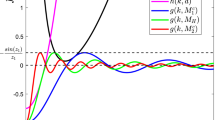Abstract
Winter hibernation constitutes an effective strategy of animals in order to correspond survive cold environments and limited availability of food, it plays an important role in biological evolution. In this work, we construct periodic switched systems describing a single population system with impulsive input toxins in polluted environment. All solutions of system (2.1) are proved to be uniformly ultimately bounded. We prove that the population-extinction solution of system (2.1) is globally asymptotically stable. The permanent condition of system (2.1) is obtained. Finally, numerical analysis is inserted to illustrate the results. Our results provide reliable tactic basis for the practical biological economics management and the protection of biodiversity.





Similar content being viewed by others
References
Wang, L.C.H., Lee, T.F.: In: Fregley, M.J., Blatteis, C.M. (eds.) Handbook of Physiology: Environmental Physiology, pp. 507–532. Oxford University Press, New York (1996)
Staples, J.F., Brown, L.: Mitochondrial metabolism in hibernation and daily torpor: a review. J. Comp. Physiol. B 178, 811–827 (2008)
Laurent, H.: Environmental Pollution, 2nd edn. Holt Rinehart and Winston, Houghton (1977)
Freedman, H.I., Shukla, T.B.: Models for the effect of toxicant in single-species and predator-prey systems. J. Math. Biol. 30, 15–30 (1991)
Hass, C.N.: Application of predator-prey models to disinfection. J. Water Pollut. Control Fed. 53, 378–386 (1981)
Hsu, S.B., Waltman, P.: Competition in the chemostat when one competitor produces a toxin. Jpn. J. Ind. Appl. Math. 15, 471–490 (1998)
Jenson, A.L., Marshall, J.S.: Application of surplus production model to access environmental impacts in exploited populations of Daphnia pluex in the laboratory. Environ. Pollut. (Ser. A) 28, 273–280 (1980)
De Luna, J.T., Hallam, T.G.: Effects of toxicants on population: a qualitiative approach, IV. Resource-consumer-toxicants model. Ecol. Model 35, 249–273 (1987)
Dubey, B.: Modelling the effect of toxicant on forestry resources. Indian J. Pure Appl. Math. 28, 1–12 (1997)
Jiao, J.J., Ye, K.L., Chen, L.S.: Dynamical analysis of a five-dimensioned chemostat model with impulsive diffusion and pulse input environmental toxicant. Chaos Solitons Fractals 44, 17–27 (2011)
Hallam, T.G., Clark, C.E., Jordan, G.S.: Effects of toxicant on population: a qualitative approach II. First order kinetics. J. Math. Biol. 18, 25–37 (1983)
Zhang, B.G.: Population’s Ecological Mathematics Modeling. Publishing of Qingdao Marine University, Qingdao (1990)
Hallam, T.G., Clark, C.E., Lassider, R.R.: Effects of toxicant on population: a qualitative approach I. Equilibrium environmental exposure. Ecol. Model 18, 291–340 (1983)
Liu, B., Chen, L.S., Zhang, Y.J.: The effects of impulsive toxicant input on a population in a polluted environment. J. Biol. Syst. 11, 265–287 (2003)
Liu, X.N.: Impulsive stabilization and applications to population growth models. J. Math. 25(1), 381–395 (1995)
Lakshmikantham, V.: Theory of Impulsive Differential Equations. World scientific, Singapore (1989)
Liu, X.N., Chen, L.S.: Complex dynamics of Holling II lotka-volterra predator-prey system with impulsive perturbations on the predator. Chaos Solitons Fractals 16, 311–320 (2003)
Song, X.Y., Chen, L.S.: Uniform persistence and global attractivity for nonautonomous competitive systems with dispersion. J. Syst. Sci. Complex. 15, 307–314 (2002)
Meng, X.Z., Chen, L.S.: Permance and global stability in an impulsive Lotka-Volterra N-species competitive system with both discrete delays and continuous delays. Int. J. Biomath. 1(2), 179–196 (2008)
Jiao, J.J., et al.: An appropriate pest management SI model with biological and chemical control concern. Appl. Math. Comput. 196, 285–293 (2008)
Murray, J.D.: Mathematical Biology, 2nd edn. Springer, Heidelberg (1993)
Kuang, Y.: Delay Differential Equation with Application in Population Dynamics. Academic Press, New York (1987)
Leung, A.W.: Optimal harvesting-coefficient control of stead-state prey-predator diffusive Volterra–Lotka system. Appl. Math. Optim. 31, 219–241 (1995)
Jury, E.L.: Inners and Stability of Dynamics System. Wiley, New York (1974)
Acknowledgments
Supported by National Natural Science Foundation of China (11361014,10961008), the Science Technology Foundation of Guizhou Education Department (2008038), and the Science Technology Foundation of Guizhou (2010J2130).
Author information
Authors and Affiliations
Corresponding author
Rights and permissions
About this article
Cite this article
Jiao, J., Li, L. & Cai, S. Dynamics of periodic switched systems describing a single population system with impulses and hibernation. J. Appl. Math. Comput. 49, 195–212 (2015). https://doi.org/10.1007/s12190-014-0833-y
Received:
Published:
Issue Date:
DOI: https://doi.org/10.1007/s12190-014-0833-y




